Golden Myanmar
Officially known as the Republic of the Union of Myanmar, this country is the largest of the mainland Southeast Asian states by area. Nestled at the base of the Himalayas and bordered by India, Thailand, Laos, Bangladesh, China, and the Bay of Bengal, Myanmar promises a beautiful journey of culture, history, and adventure.
One of the cheapest countries to travel to, Myanmar boasts of stunning mountain ranges, nature trails, pristine beaches, and thriving cities in equal measure. With a history dating back to more than two thousand years, Myanmar is home to gorgeous Pagodas like the golden Shwedagon Monastery and huge statues of the Buddha that sit atop valleys with breathtaking mountain backdrops. The ancient UNESCO World Heritage sites of Pyu and Bagan promise a trip into the glorious past of the country, while the serene and idyllic beaches at Ngwesaung and Thandwe are the perfect getaway from the bustle of the city.
Adrenaline junkies are in for a treat here, with hot air balloon rides, high treks, snorkelling, paragliding, and camping opportunities aplenty – these are easy on the pocket too, so budget travellers can try their hand at adventure too. The mirror-like Inle Lake offers a charming boat ride serenaded by the mountains and swaying palms. In contrast, the bustling night street markets ensure the perfect mix of culture, history, and fun!
This predominantly Buddhist country is famous for its arts and crafts, especially its sand paintings and drapes. With the perfect blend of Tibetan, Indian, Chinese and Thai cuisine, the multicultural Burmese food is a must-try for its delectable spices, decadent meat, and creamy sauces. The country holds a host of surprises for solo travellers, honeymooners, and families alike, so be prepared to be enchanted by the Golden Land of Myanmar!
Sights
Famous Historical Places In Myanmar
The Atumashi Monastery formally Maha Atulawaiyan Kyaungdawgyi is a Buddhist monastery located in Mandalay, Myanmar(Burma).[1]
It was built in 1857 by King Mindon, two years after the capital was moved to Mandalay.[1] The monastery was built at a cost of 500,000 rupees.[2] The original monastery structure was built using teak, covered with stucco on the outside, with its peculiar feature being that it was surmounted by five graduated rectangular terraces instead of the traditional pyatthats, Burmese-style tiered and spired roofs.[2] The structure burned down in 1890 after a fire in the city destroyed both the monastery and the 30 feet (9.1 m) tall Buddha image, as well as complete sets of the Tipitaka.[1] During the fire, a 19.2-carat (32 ratti) diamond, which adorned the Buddha image (originally given to King Bodawphaya by Maha Nawrahta, the Governor of Arakan) disappeared as well.[2]
In 1996, Burma’s Archaeological Department reconstructed the monastery with prison labor
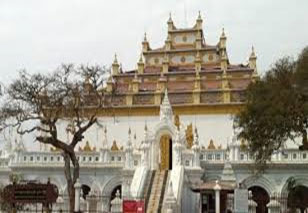
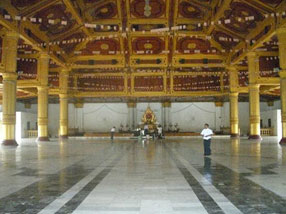
Shwenandaw Monastery (Burmese: ; lit. “Golden Palace Monastery”) is a historic Buddhist monastery located near Mandalay Hill, Mandalay Region, Myanmar (formerly Burma).
Shwenandaw Monastery was built in 1880 by King Thibaw Min, who dismantled and relocated the apartment formerly occupied by his father, King Mindon Min, just before Mindon Min’s death, at a cost of 120,000 rupees.[1] Thibaw removed the building in October 1878, believing it to be haunted by his father’s spirit.[2] The building was reconstructed as a monastery over the course of 5 years, dedicated in memory of his father, on a plot adjoining Atumashi Monastery.[2]
The building was originally part of the royal palace at Amarapura, before it was moved to Mandalay, where it formed the northern section of the Hmannan (Glass Palace) and part of the king’s royal apartments.[2] The building was heavily gilt with gold and adorned with glass mosaic work.[1]
The monastery is known for its teak carvings of Buddhist myths, which adorn its walls and roofs. The monastery is built in the traditional Burmese architectural style. Shwenandaw Monastery is the single remaining major original structure of the originalRoyal Palace today
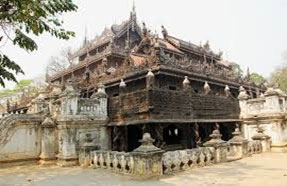
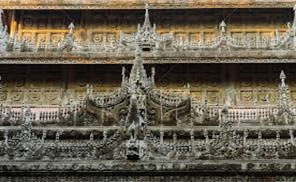
Kyaiktiyo Pagoda (also known as Golden Rock) is a well-known Buddhist pilgrimage site in Mon State, Myanmar. It is a small pagoda (7.3 metres (24 ft)) built on the top of a granite boulder covered with gold leaves pasted on by devotees. According to legend, the Golden Rock itself is precariously perched on a strand of the Buddha’s hair. The balancing rock seems to defy gravity, as it perpetually appears to be on the verge of rolling down the hill. The rock and the pagoda are at the top of Mt. Kyaiktiyo. It is the third most important Buddhist pilgrimage site in Burma after the Shwedagon Pagoda and the Mahamuni Pagoda. A glimpse of the “gravity defying” Golden Rock is believed to be enough of an inspiration for any person to turn to Buddhism
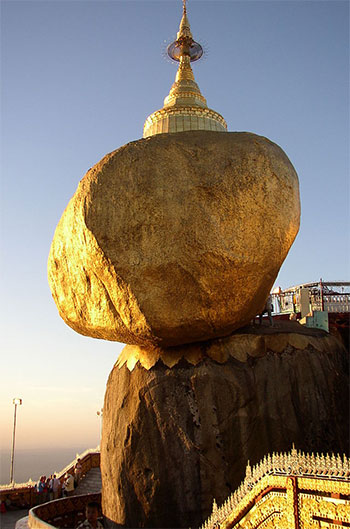
The legend associated with the pagoda is that the Buddha, on one of his many visits, gave a strand of his hair to Taik Tha, a hermit. The hermit, who had tucked it in the tuft of his hair safely, in turn gave the strand to the king, with the wish that the hair be enshrined in a boulder shaped like the hermit’s head. The king had inherited supernatural powers from his father Zawgyi, a proficient alchemist), and his mother, a naga serpent dragon princess. They found the rock at the bottom of the sea. With the help of the Thagyamin, the king of Tawadeintha Heaven in Buddhist cosmology, found the perfect place at Kyaiktiyo for locating the golden rock and built a pagoda, where the strand was enshrined. It is this strand of hair that, according to the legend, prevents the rock from tumbling down the hill. The boat, which was used to transport the rock, turned into a stone. This is also worshiped by pilgrims at a location about 300 metres (980 ft) from the golden rock. It is known as the Kyaukthanban Pagoda or stupa (literal meaning: stone boat stupa).[1][6][7]
Legends also mention that pilgrims undertaking the pilgrimage by trekking from the Kinpun base camp three times consecutively in a year will be blessed with wealth and recognition.
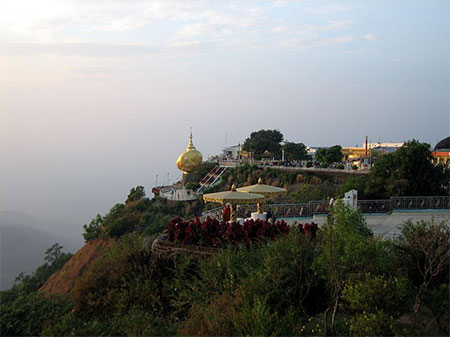
The pagoda is located near Kyaikto in Mon State in the northern part of the Tenasserim coast. The Golden Rock is situated at an elevation of 1,100 metres (3,600 ft) above mean sea level, on top of the Kyaiktiyo hill (also known as Kelasa hills or Eastern Yoma mountains); it is on the Paung-laung ridge of the Eastern Yoma mountains. It is at a distance of 210 kilometres (130 mi) from Yangon.[9][10] The Kinpun village 16 km (10 mi) is at the base of Mt. Kyaiktiyo. It is the closest to the Kyaiktiyo Pagoda. From Kyaiktiyo, the foot trail or road starts for the Golden rock. On this approach, there are numerous granite boulders on the mountain, perched in precarious condition. Near the top of the mountain, there are two large lions guarding the entrance to Kyaiktiyo Pagoda. From this location, known as Yatetaung (the last point for vehicular traffic), pilgrims and visitors have to climb to the Golden Rock barefoot, after leaving their footwear behind, as per Burmese custom.[1][3][7][11] The paved mountain track, built in 1999, from the bus terminal at Yatetaung, is along a dusty section with kiosks on both sides and the climb of 1.2 km up to the Golden Rock is stiff and takes about one hour to reach.[1] From the base camp at Kinpun, the hiking trek to the pagoda is about 11 kilometres (6.8 mi) and many devotees do this trek as part of the pilgrimage rites.[12] There are also many temples and pagodas, which have been built recently on other hills in the vicinity of the Kyaiktiyo Pagoda that are visited by pilgrims and tourists by trekking along foot tracks
The Mahagandayon Monastery, which located in Amarapura, is one of the largest teaching monasteries in Myanmar. It is usually one of the destinations of tour itineraries to Mandalay. If you are travelling independently, just ask your driver to take you to the monastery. In the Buddhist Lent Festival, thousands of monks converge on this monastery, contributing to the religious atmosphere of Amarapura.
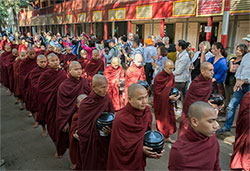
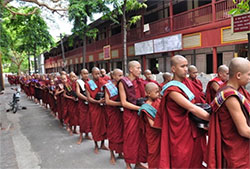
Mahamuni Paya is an ancient Buddhist temple located in the city of Mandalay in Myanmar. Home to the 13-feet-high statue of seated Buddha, it is a major pilgrimage site for the Burmese, known for over 8 tons of gold leaves surrounding the image for about 6 inches. It is among the famous attractions for people visiting the city who come to witness the sacred morning bathing ritual at 4:30 AM every day.
The temple was built in 1756, but the image of the Buddha is believed to be over 2500 years old and is believed to be one of the five remaining sacred Buddha statues, which was constructed when he was alive. It is a national icon and a holy site, where many festivals happen throughout the year. Mahamuni Paya Pwe, held every February, is the biggest of all, where processions and fairs take place for over a week.
The most popular Mahavihara of the ancient times, a significant Buddhist seat of academic excellence and a modest pilgrim center, all wrapped in a wisp of spirituality, Nalanda continues to be an equally enriching location in the present. It offers vibrant substance of spirituality, history, culture, architecture, and tourism.
This city houses one of the world’s oldest and finest residential universities which itself was an architectural masterpiece. Although in ruins, the entire complex presents a pretty picture and is flocked by tourists day in and day out. It has “viharas” or monasteries to the east and “chaiyas” or temples to the west. In addition to this, the complex houses a charming little museum, which has a collection of several of original Buddhist stupas, Hindu and Buddhist bronzes, coins, terracotta jars, a sample of burnt rice etc. The district is believed to be a cradle of religions. Apart from Buddhism, it is an important center for Jainism, Hinduism, and Sufism as well. Considering the rich heritage and the historical importance, it is a hot tourist destination.
Bagan is an ancient city located on the banks of the Irrawaddy (Ayeyarwady) River in Mandalay region in Central Myanmar. Bagan was formerly a capital and a centre of a powerful Pagan empire which flourished for over 400 years. Today, it is a renowned UNESCO heritage site. The old town area is one of the most visited destinations in the country, who visit the Bagan Archaeological Zone, which comprises of the remains of over 4000 Buddhist temples and monasteries, around 1000 of which remain today.
Bagan’s rich culture, history, architecture and Buddhist temples have attracted travelers from around the world, from as early as the times of Marco Polo, who was besotted by the beauty of this town. Bagan attracts hundreds of thousands of visitors every year who romanticize the beauty of the horizon witnessing sunsets and gorgeous sunrises over these pagodas.
Hot Air Balloon rides are very popular and are one of the ways of experiencing this enriching town. Nyaung U, located 2km away from Old Bagan has become an excellent base for travelers due to plenty of cheap accommodation, restaurants and tourist amenities.
The Pindaya Caves Burmese: ; officially located next to the town of Pindaya, Shan State, Burma (Myanmar) are a Buddhist pilgrimage site and a tourist attraction located on a limestone ridge in the Myelat region. There are three caves on the ridge which runs north-south, but only the southern cave can be entered and explored. It is not known whether the other two penetrate for any extended distance into the hillside
The southernmost Pindaya cave can be entered and extends for about 490 feet along a well-worn path. It is known for its interior which contains over 8,000 images of Buddha. Some of the older statues and images in the cave have inscriptions dating to the late 18th century, or early Konbaung period, and the earliest one dates from 1773. There may be some images without inscriptions that are older, but based on the style elements, Than Tunbelieves that none of them is older than the early 18th century and even suggests 1750 as the earliest possible date. Although most statues are of late 18th and early 19th century, many other statues and images have been placed there on an on-going basis by different donors throughout the cave’s history up until the present time, from lay people to the ruling authorities. The collection as a whole forms an impressive display of Buddhist iconography and art from early Konbaung era to the modern period. No other place in Burma displays such a range of style, not only in the images, but also in the ornamental thrones and reredos which surround the images.
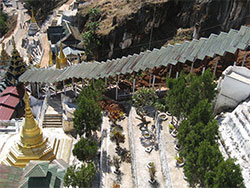
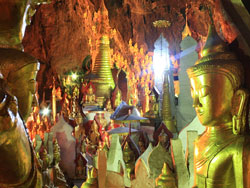
Within the cave, there are about seventy unique images of the Bhisakkaguru tradition dating to the late 18th century. They are unique in that the styling of hair, eyes, nose, ears, robe are different from most other images from Burma. The salient feature of this type of image is the holding of a seed in the upturned right palm. Than Tun reports that such images are found nowhere else in Burma, and based on Buddhist iconography, that these images are from the Mahayana tradition, and the conjecture is that the Pindaya cave at one time served the Mahayana Bhisakkaguru cult.
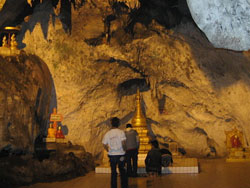
There are many legends surrounding the Pindaya cave. One is that a blocked-off path at the end of the cave leads to the ancient city of Bagan. There is also the legend of the seven princesses bathing in a lake and how they were captured by a giant spider and trapped in the cave to be rescued by Prince Kummabhaya of Yawnghwe. Sculptures of the spider and the prince aiming with his bow and arrow have been added in recent times at the entrance of the covered stairway to the caves.
The Shwemawdaw Paya (Burmese: is a stupa located in Bago,Myanmar. It is often referred to as the Golden God Temple. At 375 feet in height, the Shwemadaw holds the record for the tallest pagoda in the country although the Shwedagon Pagoda in Yangon is usually credited as the tallest pagoda in Myanmar (at 98 meters – approximately 321.5 ft). Shwemadaw, along with the Shwedagon and Kyaiktiyo, are famous Mon pagodas. The pagoda’s annual festival is a 10 day affair that takes place during the Burmese month of Tagu
The Shwemawdaw Paya was originally built around the tenth century, C.E. It was destroyed several times due to earthquakes, including one in 1917 and another in 1930. Portions of the fallen pre-1917 version of the Paya remain at the site. The original version of the pagoda was approximately 70 feet tall, built by the Mon supposedly to hold two hairs of the Buddha. Allegedly, the hairs were given personally to two Mon merchants named Mahasala and Kullasala by the Buddha on a trip to India. Tooth relics were also added to the pagoda in 982 and 1385. Further additions to the temple include a bell from King Dhammazedi, a crown from King Bayinnaung, and a spire umbrella from King Bodawpaya. The current stupa, as of its most recent rebuilding, stands at 375 feet, making it the tallest in Myanmar.
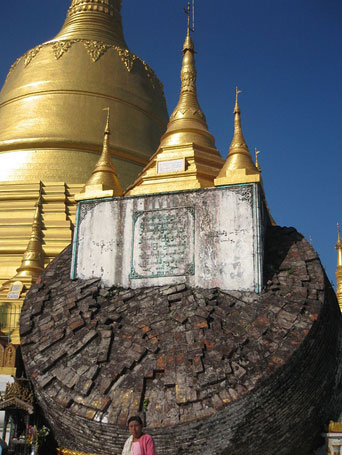
The Shwesandaw Pagoda (is a Buddhist pagoda located in Bagan, Burma. The pagoda contains a series of five terraces, topped with a cylindrical stupa, which has a bejewelled umbrella (hti). The pagoda was built by King Anawrahta in 1057, and once contained terra cotta tiles depicting scenes from the Jataka. Enshrined within the pagoda are sacred hairs of Gautama Buddha, which were obtained from Thaton
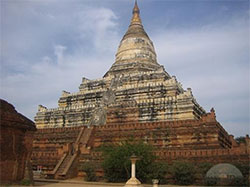
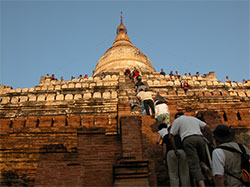
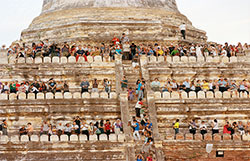
The Shwethalyaung Buddha officially is a reclining Buddha in the west side of Bago (Pegu), Burma (Myanmar). The Buddha, which has a length of 55 m (180 ft) and a height of 16 m (52 ft), is the second largest Buddha in the world, after the 74 m reclining Buddha in Dawei (Tavoy). The Buddha is believed to have been built in 994, during the reign of Mon King Migadepa. It was lost in 1757 when Pegu was pillaged. During British colonial rule, in 1880, the Shwethalyaung Buddha was rediscovered under a cover of jungle growth. Restoration began in 1881, and Buddha’s mosaic pillows (on its left side) were added in 1930.
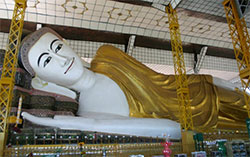

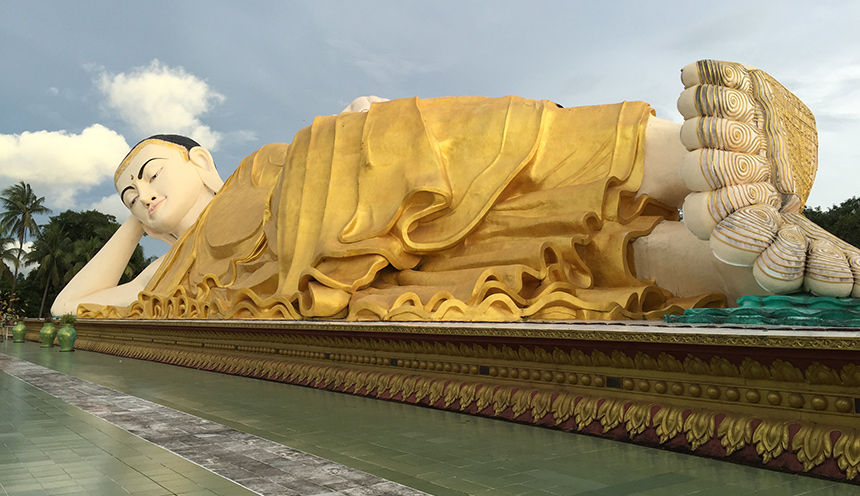
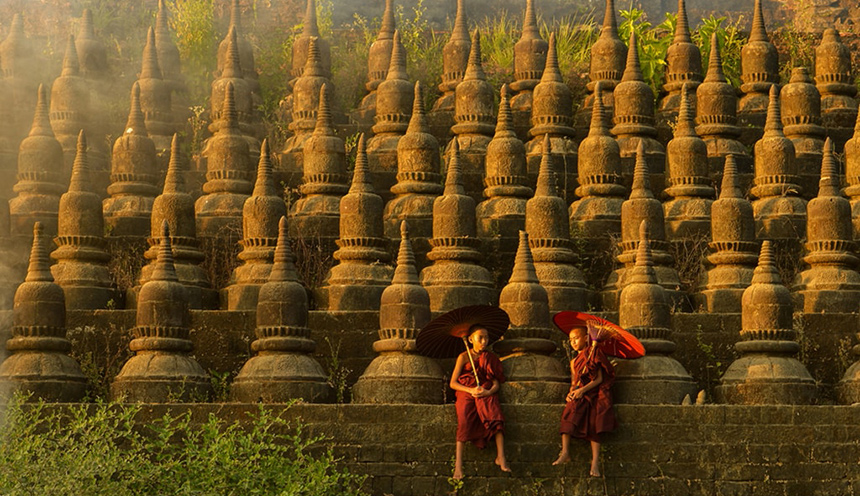
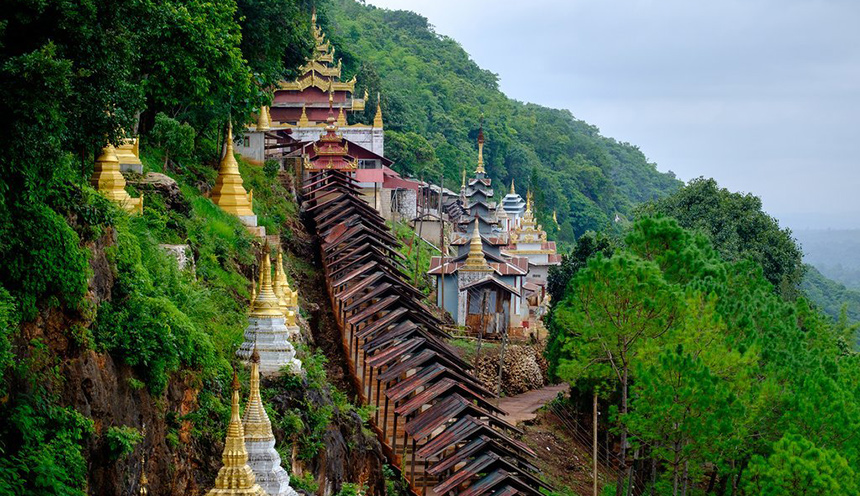
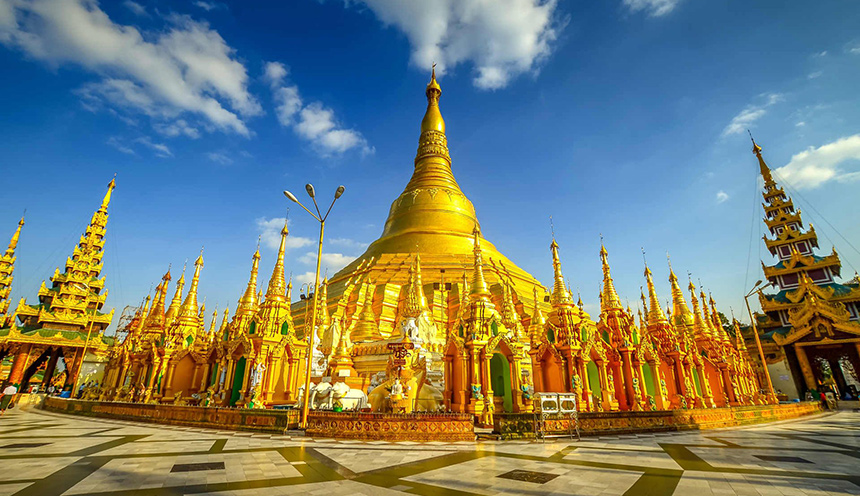
Leave a Review